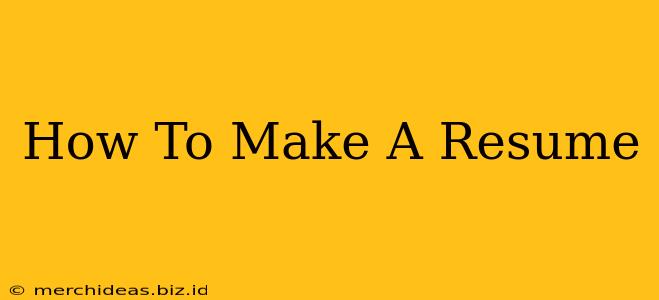Landing your dream job starts with a killer resume. This comprehensive guide will walk you through creating a resume that not only showcases your skills and experience but also grabs the attention of recruiters and hiring managers. We'll cover everything from choosing the right format to crafting compelling bullet points, ensuring your resume stands out from the competition.
Choosing the Right Resume Format
Before you start writing, decide which resume format best suits your experience level and the job you're applying for. There are three main types:
1. Chronological Resume
This is the most common format, listing your work experience in reverse chronological order (most recent first). It's ideal if you have a consistent work history and want to highlight your career progression.
Strengths: Easy to read and understand, clearly shows career progression.
Weaknesses: Can highlight gaps in employment or career changes.
2. Functional Resume
This format focuses on your skills and abilities rather than your work history. It's best if you have gaps in your employment, have frequently changed careers, or are entering a new field.
Strengths: Highlights skills relevant to the job, downplays employment gaps.
Weaknesses: Can seem less transparent about work history, may not be preferred by all recruiters.
3. Combination Resume
This format combines elements of both chronological and functional resumes. It showcases both your skills and your work experience. This is a versatile option for many candidates.
Strengths: Balances skills and experience, adaptable to various situations.
Weaknesses: Can be longer than other formats, requires careful organization.
Crafting Compelling Content: The Key Sections
No matter which format you choose, your resume should include these essential sections:
1. Contact Information
This is crucial! Include your:
- Full Name: Use a professional and easily readable font.
- Phone Number: Ensure it's a number you can reliably answer.
- Email Address: Use a professional-sounding email address.
- LinkedIn Profile URL (Optional): A well-maintained LinkedIn profile can boost your credibility.
- Location (City and State): Avoid including your full address for privacy reasons.
2. Summary/Objective Statement (Optional)
A brief summary highlighting your key skills and career goals can make a strong first impression. Use this section to quickly grab the reader's attention. An objective statement is more suitable for entry-level candidates.
3. Skills Section
List both hard skills (technical abilities) and soft skills (interpersonal abilities). Tailor this section to the specific job description. Consider using keywords from the job posting.
4. Work Experience
This is the most important section. For each role, include:
- Job Title:
- Company Name:
- Dates of Employment:
- Responsibilities and Achievements: Use action verbs and quantify your accomplishments whenever possible (e.g., "Increased sales by 15%," "Managed a team of 5"). Focus on results, not just duties.
5. Education
List your degrees, certifications, and relevant coursework. Include the name of the institution, degree earned, major, graduation date (or expected graduation date), GPA (if above 3.5), and any relevant honors or awards.
6. Awards and Recognition (Optional)
Include any awards, honors, or recognitions you've received that are relevant to the job you're applying for.
Making Your Resume Stand Out
- Use Keywords: Incorporate keywords from the job description to help your resume get noticed by Applicant Tracking Systems (ATS).
- Quantify Your Achievements: Use numbers and data to demonstrate the impact of your work.
- Use Action Verbs: Start your bullet points with strong action verbs to make your accomplishments more impactful.
- Tailor Your Resume: Customize your resume for each job you apply for. Don't send out the same resume for every application.
- Proofread Carefully: Errors in grammar and spelling can ruin your chances. Have someone else proofread your resume before submitting it.
- Use a Professional Font and Layout: Choose a clean, easy-to-read font like Times New Roman, Arial, or Calibri. Use a consistent formatting style throughout.
Optimizing Your Resume for Search Engines (SEO)
While your resume isn't directly indexed by search engines like Google, optimizing it for Applicant Tracking Systems (ATS) is crucial. ATS software scans resumes for keywords, so using relevant keywords throughout your resume significantly increases your chances of getting noticed.
By following these tips, you can create a resume that effectively showcases your qualifications and helps you land that interview! Remember, your resume is your first impression – make it count.
